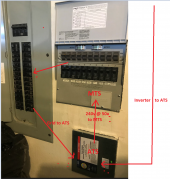Most AIO's are off grid inverters. Only a few are capable of grid tie. He doesn't need grid tied, because he has no need for exporting power to the grid.
Many off grid AIO's are stackable. (Growatt, MPP, EG4, just to name a few) off grid AIO's usually have an AC in connection. This can be fed by grid or generator. This is used to supplement or take over for low solar production.
I understand what you say but I don't agree, so let me explain. First of all who said he needs an AIO inverter? You did. I say he needs a hybrid inverter, and a hybrid inverter is capable of on-grid, off-grid, and grid-tie capabilities. Most brand name full-house inverters are hybrid inverters not AIO inverters. They include but are not limited to Lux Power, GSL Energy, Amensolar, Deye, Sol-Ark, Huayu, Outback, Schneider, Growatt, MPPSolar, SunGoldPower, and more. Grid-tie means you are tied to the grid, and grid interactive means that you can interact with the grid. Neither of those imply that the inverter is PV-only or must unconditionally feed power back to the grid. What you are referring to is a PV inverter and those are grid-tie capable, but that doesn't make everything else not grid-tie capable. So I can say he needs a grid-tie inverter and mean what I mean and not mean what you mean. For example, you can have a grid-tie inverter that has no solar inputs such as the old Schneider XW+ from almost a decade ago. Its not a hybrid, its not a PV inverter, but it is most definitely grid-tied. It has a connection to the grid, a 60A pass-through, and you can choose to charge your batteries with wind power and sell your battery power to the grid if you want to.
Back to the member's request now. When someone says they want to use the grid to supplement their battery power, they don't mean going off-grid. They mean using the grid to supplement their battery power. The reason is that most people can't afford a battery large enough to store all the power they need to go off grid. If they need 15kW immediately and their batteries are dead or charging, or their battery or inverter can't provide all of the power they need, then what they want is the power to be supplied by the grid automatically and instantaneously through a pass-through without a flicker. No mode changes, no prioritization of loads, no load balancing in advance for on-grid or off-grid use, no limitations in what you can run, no critical loads panel, just additional power from the grid now.
So Let's review what the request was really about.
1.
I'm wanting to greatly reduce my grid power bill as much as possible from ~
16kw of roof mounted panels.
2. I'd like
any excess power generated
stored in batteries for
use at night or when the PV is too low to compensate for big loads like AC/Dryer/Water Heater.
3.
When either the batteries need to be charged or the PV array cannot supply enough power I'd like to use the grid to power my home and charge the batteries.
4. I was thinking i would do this with... and a
some kind of smart controller to
automatically supplement battery/PV power
with grid power. 5. The EG4 6.5KW inverters
support grid input, and I have no interest in net metering, but
my grid is typically very reliable and i know we won't be able to get all of our power from solar.
6.
I also do not want to install a "critical load panel".
7.
I was hoping for a dual inverter setup
with grid input, battery backup and
automatic switching with no net metering. In otherwords
maximizing the
PV and batteries as much as possible
before utilizing the grid.
I see several options with these inverters
using grid power, but
all of them have a critical load panel.
8. So
is there a way to get grid power to supplement PV/battery without a critical loan panel using the EG4 6.5KW inverters?
This is obviously not a request for an off-grid solution. The member wants to stay on the grid and simply have the grid supplement his power needs without interruption or hassle when PV and battery cannot do it alone. He specifically asks, "is there a way to get
grid power to
supplement PV/Battery
without a critical load panel?"
The solution I offered previously meets all of his criteria. All hybrids today are stackable. The one I proposed is stackable up to 10 units, but what is he going to do with two inverters? He only has 16kW of power from 6 hours a day at best. If he doesn't use any of it while the sun is shining, a single 12k inverter will drain his battery dry before morning. Two will drain it dry before midnight. Besides he has the grid to supplement any additional power over the 12kW the inverter will provide, which is what he desires. The 200A pass-through isn't more than he needs, its what most hybrid inverters 12k and up are coming with now, and that feature alone addresses his need not to install a critical loads panel. Unless you have a specific reference to an inverter that has a pass-through equal to his current service, then a 200A will suffice. Finally it costs less to buy the 12k (with 18k-PV) inverter I recommended than two of the 6k inverters you recommended, and they aren't nearly as feature rich. Prove otherwise.






